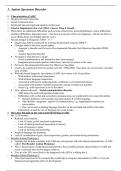3. Autism Spectrum Disorder
1. Characteristics of ASD?
o Reciprocal social interaction
o Social Communication
o Restricted interests/rigid and repetitive behaviours.
=> Triad of Impairment (Lai et al (2014), Lancet; Wing & Gould)
o Often there are additional difficulties such as noise sensitivities, mood disturbances, motor difficulties,
attention difficulties, digestion issues – but these are not part of the core diagnosis - but the do often co-
occur (think about our multiple deficits view).
o Recent changes in Diagnosis: DSM – V 1
Diagnosing ASD is conducted by a trained professional using the DSM-V.
Changes made in the most recent update:
- Asperger’s disorder and Pervasive Developmental Disorder-Not Otherwise Specified (PDD-
NOS)
- Autistic Spectrum Disorder
No longer a triad but now a dyad!
- Social communication and interaction have been merged
- Imagination/restricted repetitive behaviours, interests of actions is the same.
Pervasive Developmental Disorder-Not Otherwise Specified.
Used to be a distinction between autism and AD + PPD-NOS. Now these are covered into a broader
term of ASD.
With this broad diagnostic description of ASD, also comes a list of specifiers:
- With/without intellectual impairment
- With/without language impairment
- Associated with known medical/genetic conditions or environmental factors
- Associated with another neurodevelopmental, mental or behaviour disorder
- Onset (e.g. with regression) is to be described
New, adjacent disorder – Social communication disorder.
- ASD minus the restricted/repetitive behaviours
- Difficulties with verbal and nonverbal communication, not explained by low nonverbal ability
Includes problems with learning and using spoken & written language.
Also includes ‘pragmatic’ aspects of communication, e.g. inappropriate responses in
conversation.
=> This can be seen as linking language disorder on the one hand and ASD on the other.
Particularly around the use of language for social means.
2. How does this look in the real-world? Red Flags of ASD.
o By 12-24 months:
Reduced social interest:
- Lack of warm, joyful emotional expressions
- Lack of Sharing emotional enjoyment or interest
- Lack of response to name
- Lack of showing and interacting
Atypical language development.
Lack of coordination of gaze, facial expression, gesture, and sound during interactions.
o Broader Autism Phenotype 1
Families that include a member with ASD may also present with sub-clinical characteristics of ASD
called: The Broader Autism Phenotype
This is the presence of subclinical characteristics that resemble primary characteristics of ASD and
occur at elevated rates in first degree relatives.
You are also 30% more likely to be diagnosed with ASD if a sibling has it.
o Broader Autism Phenotype 2
This observation has led to research that could help to recognise antecedents to ASD, so it can be
diagnosed and supported earlier in development.
, Sibling/Family-risk Studies:
- Compare infants with familial risk and those with out
- Examine development and characteristic before a formal diagnosis can be made
- ASD has been assessed for at ~36 months - consider which observed variables predict ASD.
o Prevalence
Steep increase in prevalence, particularly since the year 2000 (USA especially, but also globally)
- In 1978, the prevalence was 0.04% (Rutter, 1978)
- 157 per 10,000 (~1.5%; Baron-Cohen et al., 2009)
o Real prevalence increase? 1 Maybe not?
Increased Awareness (Medical, educational, and general population so more likely to be picked up)
Change in diagnostic criteria
Broadening of autism concept
Diagnostic substitution (intellectual Disability – ASD)
Inaccurate diagnosis (Substitution ID used to be primary diagnosis, now the other way around)
o Real prevalence increase? 2 Maybe yes?
Possible environmental causes:
- MMR Vaccination – DEBUNKED!
- More premature babies surviving. More babies with perinatal complications surviving.
- Parental age? Environmental toxins?
- Maternal immune response in pregnancy?
Flu infection/prolonged fever/antibiotics (Attladottir et al., 2012)
o Prevalence – more boys than girls?
More common in males (4:1 LF; 6:1 HF)
Is this really the case? It could be, but reports are showing more and more girls and women are
being diagnosed later in life 9 (better able to mask/mirror behaviours)
This is because they present differently from boys
3. Theories of ASD and their Neuropsychology
o A brief History
1943 - Leo Kanner attributed autism to “a genuine lack of maternal warmth”; the mothers of
autistic children “just happen to defrost enough to produce a child”.
50s/60s - Bruno Bettleheim – maternal coldness
- Until the mid 20th Century autism was thought to originate from the emotional coldness of the
child’s mother.
- Although, neither considered the fact that these parents had other children without ASD!
1964 - Bernard Rimlan – “Infantile Autism: The syndrome and its implications for a Neural
Theory of Behaviour”
- It wasn’t until the 60s that autism was pinned as having a neurological underpinning.
1980s – Neurocognitive theories – of the developing structure and function of the mind, which
allowed us to test hypotheses about associated brain function (e.g., ToM, weak central coherence &
executive function)
- Cognitive Theories that we will be considering today, started to dominate in the 80s and became
known as neurocognitive theories as they all had prediction about how the brains of people with
ASD might differ and lead to the observed cognitive difficulties.
1990s - Neurodevelopmental Theories – theories of the developing brain structures and function of
the brain and nervous system (e.g. brain overgrowth/connectivity, under/over pruning).
- From the 90s there’s been more of a dominance of neurodevelopmental theories
A return of the refrigerator mother
- Although now the mother is technology!
- This has been resurrected by journalist Susan Greenfield
- Suggested that ASD is caused by overuse of digital technology and immersion in social media
- The cold mother has been replaced with an unfeeling iPad screen…
- Like it’s first manifestation, this current form of the refrigerator mother theory is:
Largely incoherent
Has no supporting evidence
The fact that ASD is typically diagnosed by 2-3 years of age also undermines this idea




